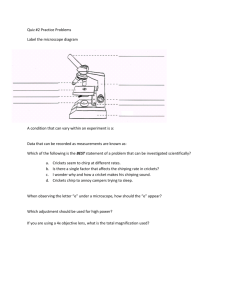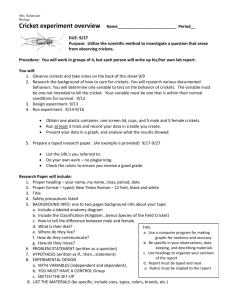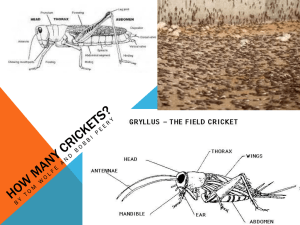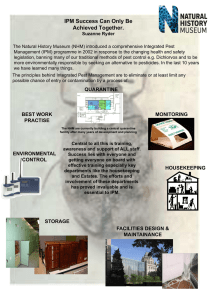P e s
advertisement
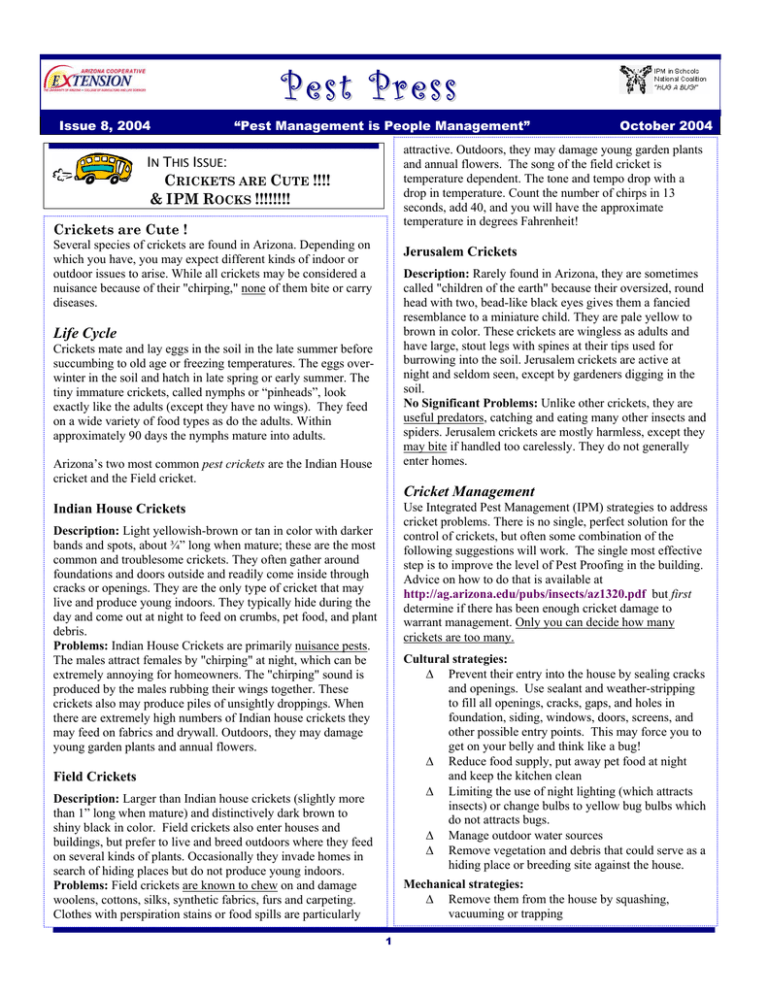
Pest Press Issue 8, 2004 “Pest Management is People Management” October 2004 attractive. Outdoors, they may damage young garden plants and annual flowers. The song of the field cricket is temperature dependent. The tone and tempo drop with a drop in temperature. Count the number of chirps in 13 seconds, add 40, and you will have the approximate temperature in degrees Fahrenheit! IN THIS ISSUE: CRICKETS ARE CUTE !!!! & IPM ROCKS !!!!!!!! Crickets are Cute ! Several species of crickets are found in Arizona. Depending on which you have, you may expect different kinds of indoor or outdoor issues to arise. While all crickets may be considered a nuisance because of their "chirping," none of them bite or carry diseases. Jerusalem Crickets Description: Rarely found in Arizona, they are sometimes called "children of the earth" because their oversized, round head with two, bead-like black eyes gives them a fancied resemblance to a miniature child. They are pale yellow to brown in color. These crickets are wingless as adults and have large, stout legs with spines at their tips used for burrowing into the soil. Jerusalem crickets are active at night and seldom seen, except by gardeners digging in the soil. No Significant Problems: Unlike other crickets, they are useful predators, catching and eating many other insects and spiders. Jerusalem crickets are mostly harmless, except they may bite if handled too carelessly. They do not generally enter homes. Life Cycle Crickets mate and lay eggs in the soil in the late summer before succumbing to old age or freezing temperatures. The eggs overwinter in the soil and hatch in late spring or early summer. The tiny immature crickets, called nymphs or “pinheads”, look exactly like the adults (except they have no wings). They feed on a wide variety of food types as do the adults. Within approximately 90 days the nymphs mature into adults. Arizona’s two most common pest crickets are the Indian House cricket and the Field cricket. Cricket Management Use Integrated Pest Management (IPM) strategies to address cricket problems. There is no single, perfect solution for the control of crickets, but often some combination of the following suggestions will work. The single most effective step is to improve the level of Pest Proofing in the building. Advice on how to do that is available at http://ag.arizona.edu/pubs/insects/az1320.pdf but first determine if there has been enough cricket damage to warrant management. Only you can decide how many crickets are too many. Indian House Crickets Description: Light yellowish-brown or tan in color with darker bands and spots, about ¾” long when mature; these are the most common and troublesome crickets. They often gather around foundations and doors outside and readily come inside through cracks or openings. They are the only type of cricket that may live and produce young indoors. They typically hide during the day and come out at night to feed on crumbs, pet food, and plant debris. Problems: Indian House Crickets are primarily nuisance pests. The males attract females by "chirping" at night, which can be extremely annoying for homeowners. The "chirping" sound is produced by the males rubbing their wings together. These crickets also may produce piles of unsightly droppings. When there are extremely high numbers of Indian house crickets they may feed on fabrics and drywall. Outdoors, they may damage young garden plants and annual flowers. Cultural strategies: ∆ Prevent their entry into the house by sealing cracks and openings. Use sealant and weather-stripping to fill all openings, cracks, gaps, and holes in foundation, siding, windows, doors, screens, and other possible entry points. This may force you to get on your belly and think like a bug! ∆ Reduce food supply, put away pet food at night and keep the kitchen clean ∆ Limiting the use of night lighting (which attracts insects) or change bulbs to yellow bug bulbs which do not attracts bugs. ∆ Manage outdoor water sources ∆ Remove vegetation and debris that could serve as a hiding place or breeding site against the house. Field Crickets Description: Larger than Indian house crickets (slightly more than 1” long when mature) and distinctively dark brown to shiny black in color. Field crickets also enter houses and buildings, but prefer to live and breed outdoors where they feed on several kinds of plants. Occasionally they invade homes in search of hiding places but do not produce young indoors. Problems: Field crickets are known to chew on and damage woolens, cottons, silks, synthetic fabrics, furs and carpeting. Clothes with perspiration stains or food spills are particularly Mechanical strategies: ∆ Remove them from the house by squashing, vacuuming or trapping 1 ∆ Apply diatomaceous earth (DE) between walls and other places where crickets hide during the day as well as to areas through which crickets walk. This abrasive, fine, white powder is actually tiny sharp fossil shells that will gradually wear through the cricket's outer shell, causing it to dehydrate and die. Wear a dust mask during application to prevent inhaling which could lead to respiratory problems. At a more local level your University Support Team consists of Jennifer L. Snyder and Dr. Dawn H. Gouge. Jen and Dawn offer technical and managerial support directly to the School District IPM Specialists in Arizona. Biological strategies: ∆ Encourage natural predators around the home (cats, lizards, birds, spiders). Choosing not to apply pesticides always goes a long way to promote natural predators and a wide diversity of creatures. IPM Rocks ! IPM stands for Integrated Pest Management. It is an approach used by pest management experts who want high levels of pest control and low levels of chemical pesticides in the environment. Your school district has decided to implement an IPM program in your school to reduce risks associated with pests and chemical pesticides. For more information contact your district IPM specialist or collaborating IPM experts at the University of Arizona (Jen jsnyder@ag.arizona.edu or Dawn dhgouge@ag.arizona.edu). Miss Jen Dr. Dawn The most important folks involved in the program are the School District IPM Specialists. These chaps are the driving force behind the program, and without their dedication and continued effort progress simply could not happen. Meet just a few of our hard working Arizona IPM Specialists: So Who’s Who in School IPM? There are several different approaches to the implementation of School IPM programs but one of the most effective and sustainable is the Monroe IPM Model (Lame, Indiana University). Dr. Marc Lame is an entomologist at heart, but also a communication and environmental management professor. The Monroe IPM Model may have been conceived by him, but is was brought to life by the Monroe County school district who worked very hard to turn the theoretical plan into a working, functioning Model. Dr. Lame has since formed a National IPM Implementation Team and travels the country initiating projects in many states. Dr. Marc Lame National IPM Team Leader Mr. Jerry Jochim works with Dr. Lame in Monroe County, Indiana. Jerry was a maintenance supervisor before becoming the IPM coordinator for Monroe County schools. He is currently the Monroe County School District Environmental Specialist and a key member of the National IPM Implementation Team. He believes strongly in education as the basis for IPM. Mr. Lee Styer Mr. Jay Romans (Scottsdale Unified) Mr. Ed Stallard Mr. Roy Morris Mesa Public Kyrene IPM is a team effort and success depends wholly on communication and cooperation of people. Managing pests is the easy part. Pest Management is People Management IPM is the first of several Children’s Environmental Health programs that will be implemented. The next layer of the program will facilitate the adoption of Tools for Schools which focuses on improving indoor air quality. For Further Info. Contact: Jennifer or Dawn, University of Arizona (520) 5682273, dhgouge@ag.arizona.edu Few bugs are bad! More than 95% of all insect species are beneficial to humans. Mr. Jerry Jochim National IPM Team Educator 2
